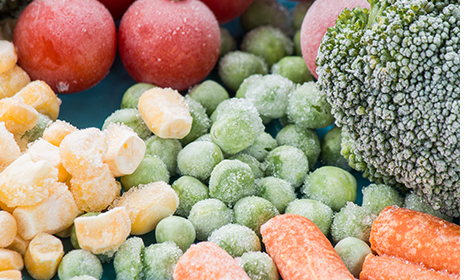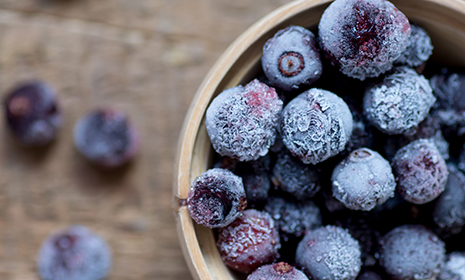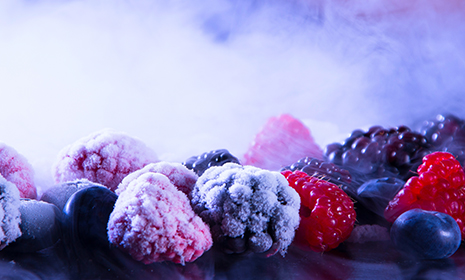
Why freeze food?
Freezers are a great way to make the most of your food - and your money. Freezing items can help to minimise food waste and is an ideal way to preserve extra portions of dishes, so you need only cook once to enjoy the same meal twice.
As freezing stops food from deteriorating, you can freeze produce right up until the use-by date.
The other great news is that you can freeze pretty much everything - bread, milk, butter, cheese, fruit, cooked meat….
General freezing advice
Freezers should be at least -18C - remember, freezers will not kill any bacteria already present, but will stop bacteria and yeasts from growing. Always wrap food well for the freezer, remove as much air as possible from the package, and use air-tight containers or bags.
Food exposed to the air can become dry, soggy, develop freezer burn, and absorb odours from other frozen foods. If food has been left exposed to the air before freezing, it may already contain some bacteria and perish sooner. Also, don't forget to label everything with the date and what it is to avoid UFOs (unidentified frozen objects).
Freezing leftovers is a great way to have ready-made meals to hand. Try to cool food as quickly as possible before putting it into the freezer - remember, if you refrigerate, food should be cool enough to maintain the fridge temperature before it's placed in. Make sure that you defrost the leftovers properly before reheating – place them in the fridge overnight, or in the microwave if you plan to use them immediately.
Never leave food on the side to defrost as the outer layers can be exposed to warm temperatures, allowing bacteria to grow.
Eat leftovers within 24 hours of defrosting and do not refreeze.
Food that has been defrosted provides the perfect temperature for bacteria to grow. When it's placed back in the freezer, these bacteria become dormant but aren't destroyed. When defrosting for a second time, bacteria are likely to reach harmful levels and may cause food poisoning.
Top freezing tips
1. Cool it…before you freeze it. If you put warm food into the freezer, it increases the temperature of the whole freezer so could affect other foods.
2. Wrap it...make sure you wrap foods properly or put them in air-tight, sealed containers, otherwise your food can get freezer burn, dry out or absorb odours from other foods.
3. Label it...it may seem a hassle at the time, but unless you label an item you won’t remember what it is, let alone when it was frozen - always add the date.
4. Portion it…freeze food in portions. You can always add a couple of portions together if you need more, but it’s impossible to divide a meal for four if you only want two portions, and you may be more likely to overeat.

How long will it last?
Freezing can keep food safe indefinitely, however, the quality of different foods deteriorates over time.
Here are some examples of how long different foods can maintain their quality in the freezer:
- Cooked meat dishes: 2-3 months
- Fresh chicken portions: 9 months
- Fresh meat (e.g. steak, pork chops): 4-12 months
- Bacon: 1 month
- Sausages: 1-2 months
- Soups and stews: 2-3 months
Defrosting
Make sure you're doing it correctly
Want to defrost an item? Before cooking or preparing it, you should ideally defrost it overnight in the fridge. The following day, use within 24 hours and cook through until it's piping hot all the way through to kill any bacteria.
If you need it quickly, food can be defrosted safely in the microwave on the defrost setting. Use the defrost power setting to ensure that foods defrost in a slow and even manner. To assist with even defrosting, turn and rotate the food every so often. With soups and stews, pause the microwave and stir them regularly and thoroughly.
Something to be aware of...
Be aware that defrosting on full power, rather than the defrost setting, may result in raw, still-frozen areas in the food, even though some parts may be piping hot. Check your microwave before beginning.
Freezer burn
This is caused by food ‘drying out’ as water leaves the food. It’s more likely to happen if you don’t wrap items tightly, or if the freezer is opened frequently. You’ll see the ‘burn’ as brownish patches on the surface of frozen/thawed food. Whilst unsightly, it doesn’t affect the taste and isn’t a food safety risk. Just trim off any affected areas before using the food.
- Don’t re-freeze food that's been frozen. If it was frozen raw and then cooked it should still be safe, but if you’re in any doubt it shouldn't be re-frozen.
- Freeze fresh. Don't freeze food past its use-by date in the hope it will somehow revitalise in the freezer. It’s perfectly safe to freeze on the use-by date but not beyond that.
- If in doubt, throw it out. Freezing doesn’t kill bacteria. If you’re a bit wary of something once defrosted, don't take any chances.
Everyday foods that are ideal to freeze
- Soups, sauces and stews.
- Bread generally freezes well for up to three months. However, French bread is better if used within a month. Sliced bread can be toasted from frozen.
- Butter and margarine can be frozen, and are perfect for three months.
- Hard cheese can be frozen for six months; if you grate it first, it can be used straight from the freezer.
- Milk freezes well for one month. Ideally, defrost in the fridge and shake well before using as it will separate.
- Blackberries or blueberries are great frozen. They can be used from frozen and last up to a year.
Freezing vegetables
When properly frozen, vegetables keep their flavour and preserve nutrients. Fresh peas, beans (any type), cauliflower, broccoli or asparagus can all be home-frozen when in season, and keep well for six months.
Batch cooking
For tasty, homemade ready meals, foods such as soups, stews or meatballs can be cooked in a batch and portioned up then stored (with any sauce) in a container so you can defrost for an instant supper.
Most baked goods such as bread or buns are ideal for batch cooking, as its usually just as easy to make double the quantity and freeze one batch for another time. Always store baked items separately, e.g. sliced or in single portions, so you can use just one portion if you wish.
Cooking from frozen
Although some dishes such as soups could be cooked straight from frozen, it's safer to defrost first.
What’s not so great to freeze...
- Pasta goes soggy when frozen, so it’s not recommended - but you can freeze it then use in soup.
- Vegetables with high water content, such as lettuce or cucumber, become limp. However, you can freeze them and use for soup.
- Yogurt, cream cheese and cottage cheese can curdle or become watery. They're ok to use in sauces but not ideal on their own.
- Raw eggs in the shell will crack, so shell them and separate into egg whites and yolks. Put into ice cube trays to use in cakes. Hard-boiled eggs become rubbery.
Tips for specific foods
Here are some top tips to help improve the quality of your food when freezing leftovers:
- Rice – must be cooled as quickly as possible. It's best to cook as much as you need to avoid the need for freezing and reheating. If you do reheat, the rice must be piping hot.
- Bread - when defrosting, remove any ice in the pack as this can thaw and cause the bread to become soggy. Use sealable freezer bags or plastic freezer wrap when freezing bread, rather than the thin, porous film in which some bake-off store breads are sold.
- Fruits – those such as apples or pears are better pureed or stewed - they are then ideal for use in pies etc. It also enables food to be frozen in individual portions. Plus, it saves space and makes better use of your freezer. Fruits can also be made into ice cream, frozen yogurt or sorbet, and served frozen.
- To serve frozen fruits ‘raw’, serve them when they still have a small amount of ice remaining, which gives a firmer texture.
- Berries – such as strawberries don’t freeze well, but can be pureed. They’re then ideal for smoothies, sauces and desserts.
- Vegetables – those with a high water content, such as tomatoes, are better pureed before freezing, they’ll then be ideal for sauces and soups.
- Sauces - can get thicker while they’re frozen, so check after thawing and reheating and, if necessary, add a little extra water. If you freeze sauces separately it helps them last longer.
- Tomato sauces - these freeze extremely well. Dairy-based sauces can still be frozen but may not be as successful as they can separate and appear curdled. A vigorous stirring helps to recombine the ingredients and they’re perfectly useable.
- Milk, yogurt or cream - can all curdle or separate when frozen depending on the fat content. Lower-fat products such as semi or full skimmed milk freeze better than full-fat. If it does separate it can still be used, just shake or stir well to recombine.

Keep your freezer at optimum efficiency
A full freezer is more economical to run. If your freezer has empty space, fill it with plastic bottles half-filled with water. The frozen bottles are also handy as disposable ice packs for picnics!
Defrost fully. An icy freezer is inefficient, so if you don’t have auto-defrost make sure you defrost it if ice builds up. Store food in the refrigerator or a large cooler with ice packs while you do this, and it will be perfectly safe for a couple of hours.
In case of emergency...if there is a power cut, don't open the freezer door. Foods should remain frozen and still be safe for about 24 hours.
